Procedures
This guide uses a standalone CloudControl deployment and does not use Active Directory. All users are local to the system. CloudControl supports a cluster environment. For more information refer to the Entrust CloudControl Installation Guide in the online documentation.
Download the CloudControl software
-
Log in and select HyTrust CloudControl.
-
Open the folder
HTCC_6.6.0_2023-02-241. This folder contains version 6.5.0 that was used in this guide. -
Select the
Entrust-CloudControl-6.6.0.660934.ziplink to download the file.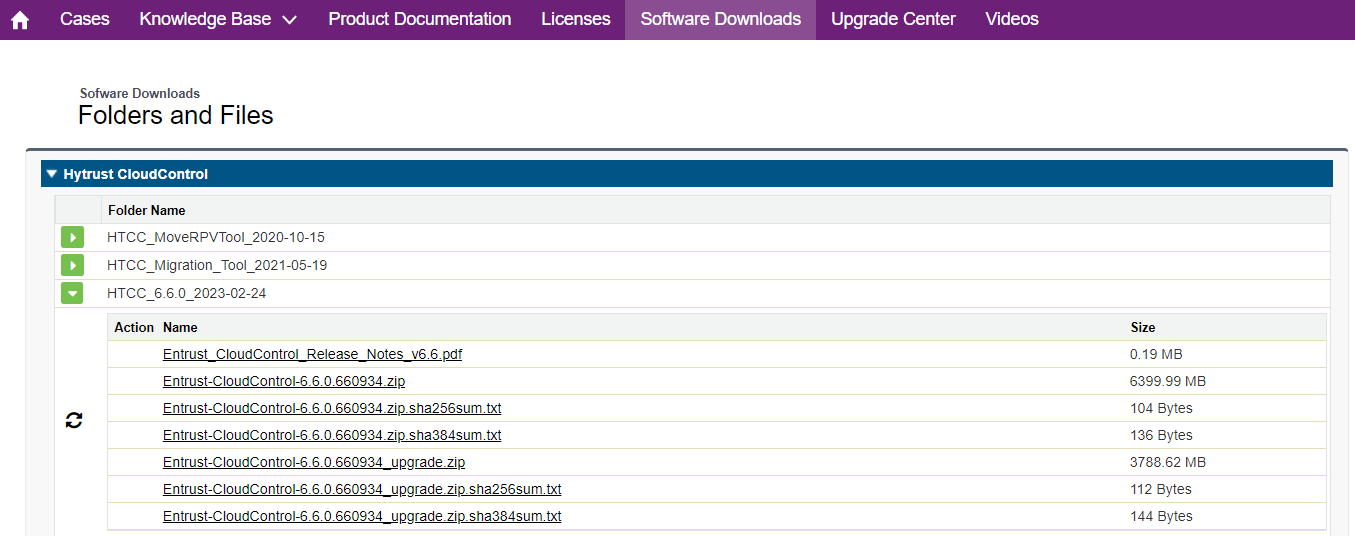
-
After the file has been downloaded, open the ZIP file to access to the OVA file.
Deploy the CloudControl VM from the OVA
-
Log in to vCenter.
-
Select the cluster to create the CloudControl VM in.
-
From the Actions menu, select Deploy OVF template.

-
Select Local File and upload the CloudControl OVA file.
-
Select Next
Follow the instructions during the deployment as needed.
| For more information refer to Installing CloudControl from an OVA in the online documentation. |
Power on the appliance
-
Log in to the vSphere Client.
-
Locate the Entrust CloudControl virtual machine in the inventory.
-
Right-click the CloudControl virtual machine and select Power > Power On.
Configure the CloudControl virtual appliance
This guide uses a Standalone Node setup. For more information refer to Creating a Standalone Node in the online documentation.
Set up the CloudControl GUI
After the standalone node has been configured, finish the setup using the GUI. For more information refer to Setting Up the CloudControl GUI in the online documentation.
VMware Tanzu prerequisites
CloudControl has some prerequisites for VMware Tanzu that must be put in place.
For more information refer to VMware Tanzu Prerequisites in the online documentation.
VMware Tanzu setup
This guide does not describe the deployment of a VMware Tanzu cluster. Refer to the VMware documentation for details.
When the VMware Tanzu cluster is set up, use the cluster kubeconfig file to onboard the cluster into CloudControl.
A client machine with kubectl installed is required to run commands specified in this guide.
The examples in this guide use a CentOS 8 virtual machine which will be referred to as the kubectl node from now on.
-
Log in to the kubectl node client machine.
-
On the kubectl node log into the VMware Tanzu Management/Supervisor cluster:
% kubectl vsphere login --vsphere-username administrator@vsphere.local --server=https://xx.xxx.xxx.xx --insecure-skip-tls-verifyWhen this command has executed successfully, use the
$HOME/.kube/configfile for onboarding. This will be the config file to onboard the Management/Supervisor cluster. Save this file in the$HOMEdirectory and name itmanagement.kubeconfig.txt.% cp $HOME/.kube/config $HOME/management.kubeconfig.txt -
To get the Tanzu Kubernetes cluster config file, log into the Tanzu Kubernetes cluster:
% kubectl vsphere login --vsphere-username administrator@vsphere.local --server=https://xx.xxx.xxx.xx --insecure-skip-tls-verify --tanzu-kubernetes-cluster-namespace qanamespace --tanzu-kubernetes-cluster-name qa-tkg-cluster-01In this example, the namespace for our cluster is qanamespace and the cluster name is qa-tkg-cluster-01. These are just examples. Enter the names that apply to the environment in use.
When this command has executed successfully, use the
$HOME/.kube/configfile for on-boarding. This will be the config file to onboard the Tanzu Kubernetes cluster. Save this file the$HOMEdirectory and name ittanzucluster.kubeconfig.txt.% cp $HOME/.kube/config $HOME/tanzucluster.kubeconfig.txt -
$HOME/.kube/configis the file needed to onboard the clusters in CloudControl. For Tanzu, use the following files:-
management.kubeconfig.txt- for the Management/Supervisor cluster. -
tanzucluster.kubeconfig.txt- for the Tanzu Kubernetes cluster.
-
Both clusters will have to be on-boarded into CloudControl.
Now add the Tanzu clusters into CloudControl, see On-board the Tanzu clusters.
On-board the Tanzu clusters
On-boarding is the process of adding the Tanzu Kubernetes clusters into CloudControl.
For more information refer to Adding a VMware Tanzu Cluster in the online documentation.
For Tanzu, import the Tanzu Management cluster and at least a Tanzu Kubernetes cluster.
On-boarding the Tanzu Management cluster
-
From the Home tab, select Inventory > Kubernetes Clusters.
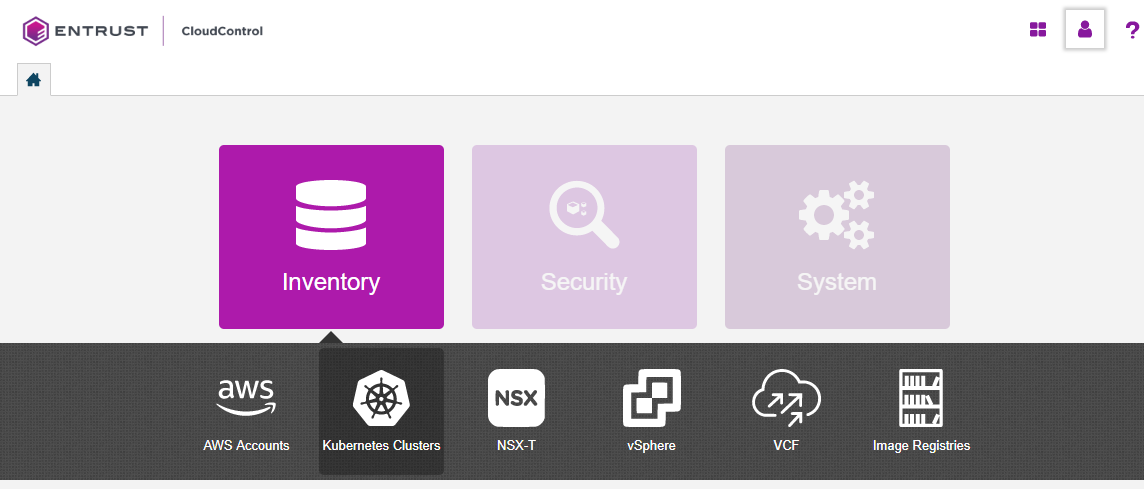
-
On the Clusters page, select Actions > Add Kubernetes Cluster.
If there are no clusters in the system, Add Kubernetes Cluster is also available on the Kubernetes Clusters page.
-
On the Add Kubernetes Cluster Import tab, choose one of the following:
-
Select Import File, then select Browse and choose the kubeconfig file to import.
-
Select Enter Text, then paste the contents of the kubeconfig file as plain text.
A kubeconfig file is a configuration file written in YAML that describes the cluster.
To import the Management cluster, use the Management cluster config file produced earlier,
management.kubeconfig.txt.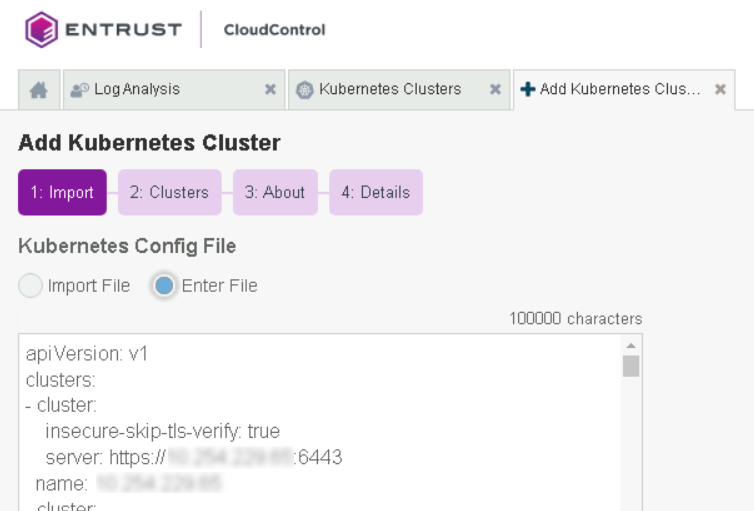
-
-
Select Enter Text, then paste the contents on the Management cluster config file as plain text.
-
Select Continue.
-
On the Clusters tab, select the Tanzu Management cluster to add and select Continue.
Only one cluster can be selected. Select the Tanzu Management cluster IP address or FQDN.
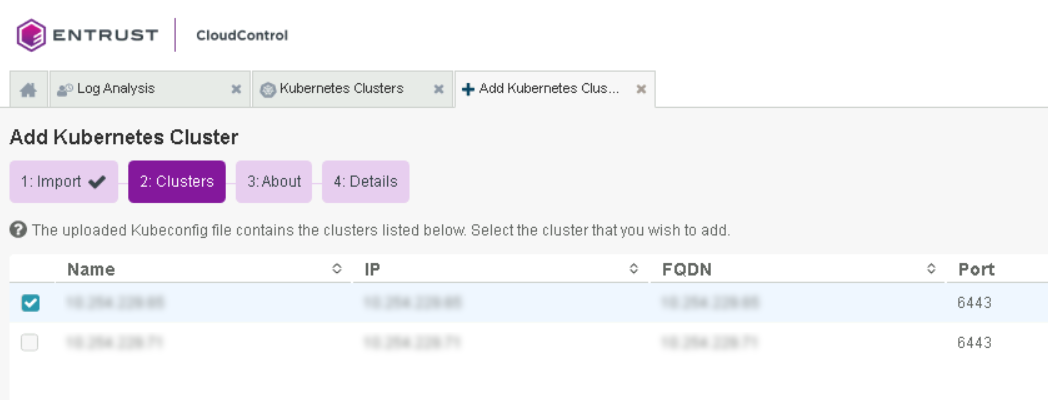
-
On the About tab, enter the following:
-
Friendly Name: Enter the user-facing name for the cluster.
-
Password: Enter the password for the user selected who has access to the cluster. In this example, that is the same password used by
administrator@vsphere.local.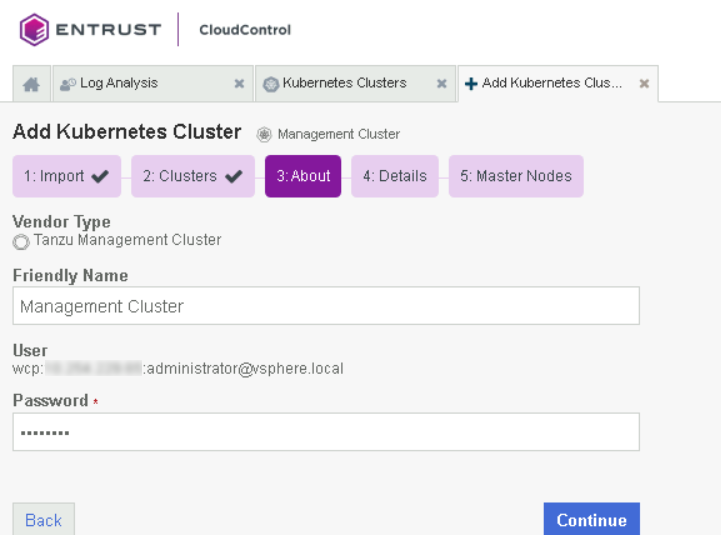
For the Vendor Type, CloudControl detects that this is a Tanzu Management cluster.
-
-
Select Continue.
-
On the Details tab, monitor the process.
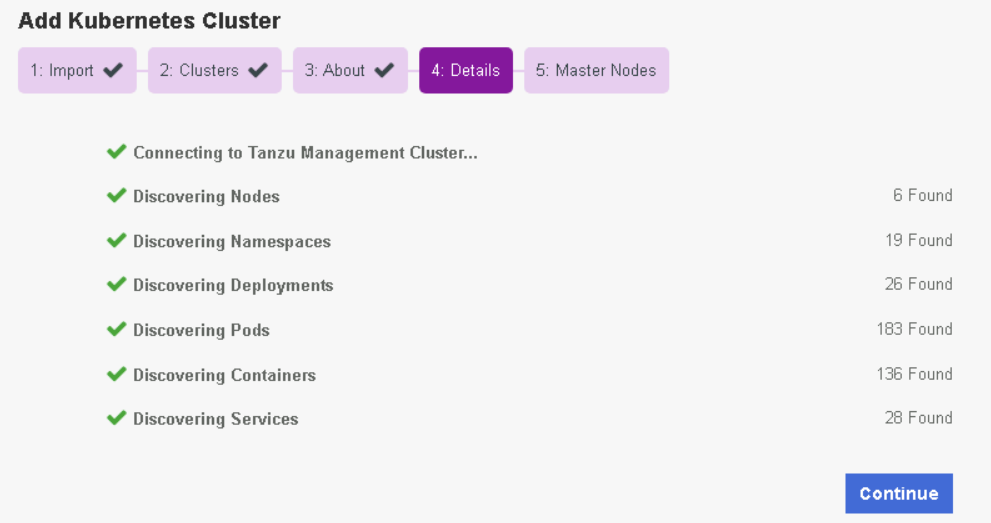
-
Select Continue.
-
On the Master Nodes tab, a list of nodes will be displayed with their name, IP, and hostname information.
-
Select Continue.
-
After the cluster has been imported into CloudControl the cluster dashboard is shown.
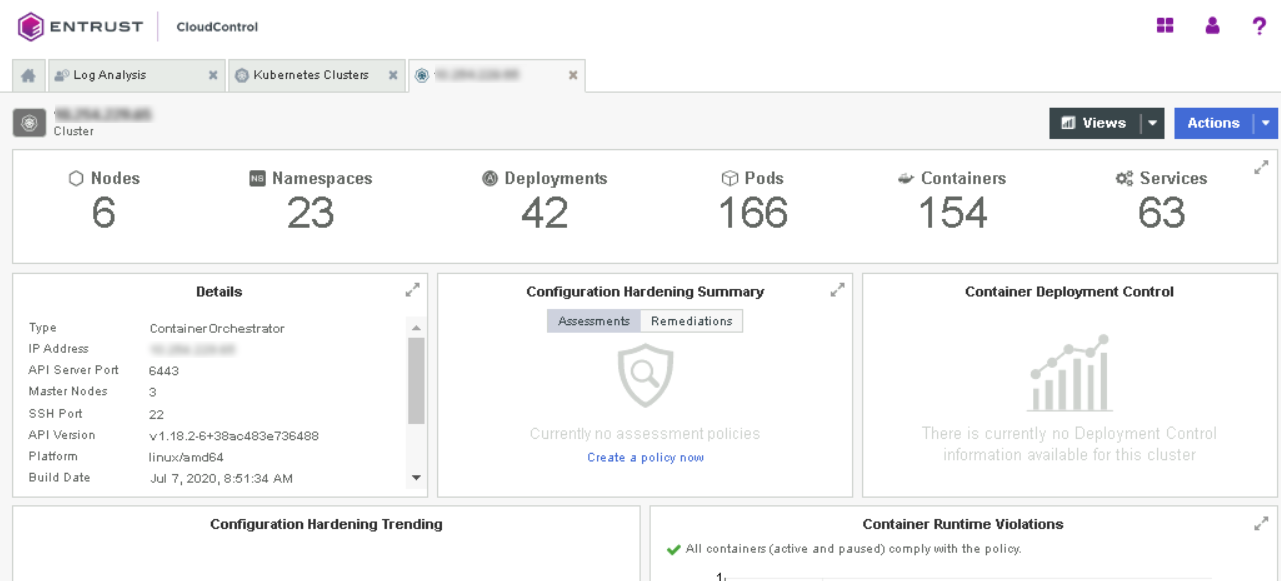
On-boarding the Tanzu Kubernetes cluster
After the Tanzu Management cluster has been on-boarded, import a Tanzu Kubernetes cluster.
-
From the Home tab, select Inventory > Kubernetes Clusters.

-
On the Clusters page, select Actions > Add Kubernetes Cluster.
-
On the Add Kubernetes Cluster Import tab, select Enter Text, then paste the contents of the kubeconfig file as plain text.
To import the Tanzu Kubernetes cluster, use the Tanzu cluster config file
tanzucluster.kubeconfig.txt.
-
Select Enter Text, then paste the contents on the Tanzu Kubernetes cluster config file as plain text.
-
Select Continue.
-
On the Clusters tab, select the Tanzu Kubernetes cluster to add and select Continue.
Only one cluster can be selected. Select the Tanzu Kubernetes cluster IP address or FQDN.

-
On the About tab, enter the following:
-
Friendly Name: Enter the user-facing name for the cluster.
-
Password: Enter the password for the user who has access to the cluster. In this example, that is the same password used by
administrator@vsphere.local.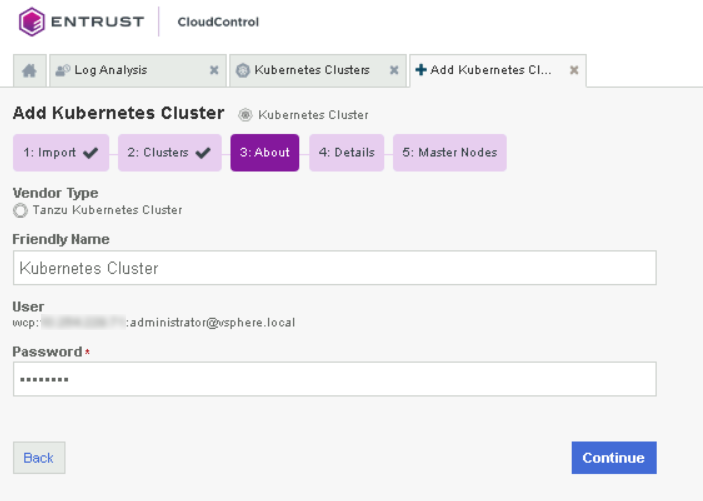
For the Vendor Type, CloudControl detects that this is a Tanzu Kubernetes cluster.
-
-
Select Continue.
-
On the Details tab, monitor the process.
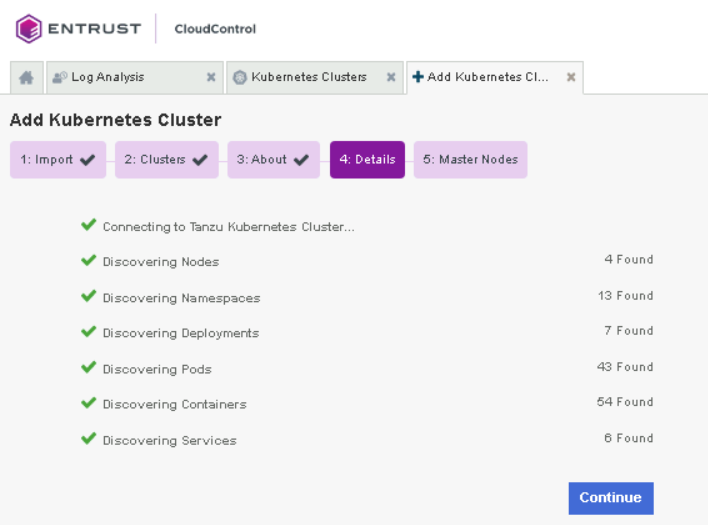
-
Select Continue.
-
On the Master Nodes tab, a list of nodes will be displayed with their name, IP, and hostname information.
-
Select Continue.
-
In the Enable Access Control dialog, either:
-
Select Enable Access Control to enable the ROOT Access Control Trust Manifest. CloudControl will take control of managing access to the cluster. Create a Trust Manifest Access Control Policy to be able to create and manage objects in the cluster.
-
Select No, not now to wait until later. This feature can be enabled after the cluster has been onboarded.
-
-
After the cluster has been imported into CloudControl the cluster dashboard is shown.
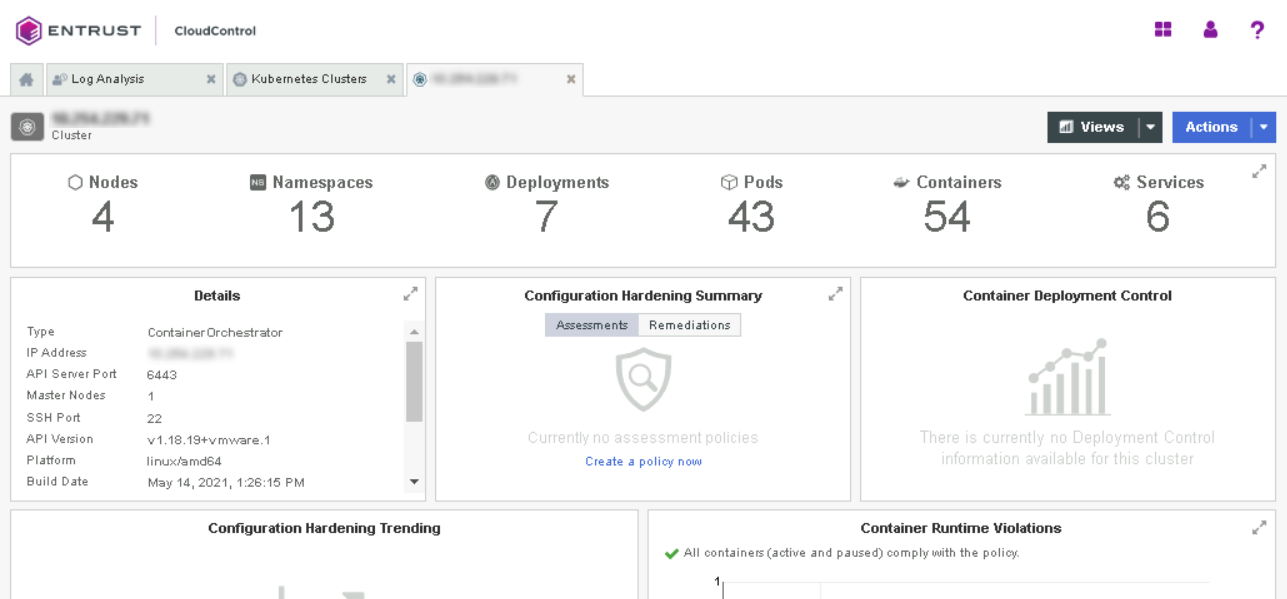
View VMware Tanzu Kubernetes cluster inventory
From the Home page, select Inventory > Kubernetes Clusters to view the Kubernetes Clusters page. From here, in depth information of all of the objects in that cluster can be viewed, as well as any tags or policies related to those objects. This information is included in a dashboard or a resource page.
For more information refer to Viewing Kubernetes Inventory in the online documentation.
Also refer to Navigating Kubernetes Inventory View Pages in the online documentation.
Transfer root access control to CloudControl
When root access control is enabled in the Kubernetes cluster, access control of the Tanzu Kubernetes cluster is transferred to CloudControl. This means that management of objects in the cluster will be controlled by CloudControl rules. These rules must be created and defined in CloudControl for the user to be able to create, edit, and delete objects in the cluster.
Before root access control is enabled
During the on-boarding process, root access was not enabled for the imported cluster. As a result, the user can still create objects at the Tanzu level.
For example, the user could create a pod.
The pod.yaml file is below:
apiVersion: v1
kind: Pod
metadata:
name: tutum-centos3
spec:
containers:
- name: tutum-ssh-server3
image: tutum/centosTo create the pod:
% kubectl vsphere login --vsphere-username administrator@vsphere.local --server=https://xx.xxx.xxx.xx \
--insecure-skip-tls-verify --tanzu-kubernetes-cluster-namespace qanamespace \
--tanzu-kubernetes-cluster-name qa-tkg-cluster-01
Password:
Logged in successfully.
You have access to the following contexts:
xx.xxx.xxx.xxx
ameynamespace
ameynamespace-xx.xxx.xxx.xxx
amolnamespace
qa-tkg-cluster-01
qanamespace
qanamespace-xx.xxx.xxx.xxx
saketnamespace
saketnamespace-xx.xxx.xxx.xxx
subbanamespace
wld1
If the context you wish to use is not in this list, you may need to try
logging in again later, or contact your cluster administrator.
To change context, use `kubectl config use-context <workload_name>`
% kubectl create -f pod.yaml
pod/tutum-centos3 createdThe pod is created successfully. This process will fail if root access control is enabled using default HyTrust Global Access Control Policy, which denies all operations. See Enable root access control.
To delete the pod:
% kubectl get pods
NAME READY STATUS RESTARTS AGE
tutum-centos3 1/1 Running 0 3m57s
% kubectl delete pod tutum-centos3
pod "tutum-centos3" deletedThe pod is deleted successfully. This process will fail if root access control is enabled using default HyTrust Global Access Control Policy, which denies all operations. See Enable root access control.
Enable root access control
When root access control is enabled for the Kubernetes cluster, access control of the Tanzu Kubernetes cluster is transferred to CloudControl.
To enable root access control:
-
From the Home tab, select Inventory > Kubernetes Clusters.

-
Select Management to view the clusters.
-
Select the Tanzu Kubernetes Cluster Name link.
This action will display the details about the selected cluster.

The Details section of the page shows that Access Control is Disabled.
-
Select the Disable link to Enable Root Access Control.
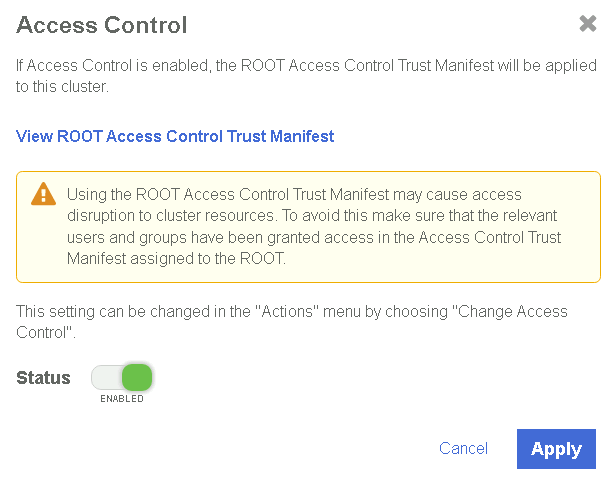
-
In the Access Control dialog, set Status to Enabled and select Apply.
After root access is enabled, it is not possible to work with objects directly. For example, the user could create a pod:
% kubectl create -f pod.yaml
Error from server (Forbidden): error when creating "pod.yaml": admission webhook "accesscontrol.hytrust.com" denied the request: Permission Denied by HyTrust Security Policy.In this example, it is not possible to create the pod, as CloudControl now controls permissions on the cluster. To perform these actions, user permissions must be granted through a policy, see Create a Trust Manifest Access Control Policy.
Create a Trust Manifest Access Control Policy
After root access control is enabled in the cluster, the user is unable to create objects in the cluster. This is because cluster permissions are then managed by CloudControl.
This section describes the process to create a Trust Manifest Access Control policy, so a user can manage objects in the cluster.
Log analysis
Use the logs in the system to check why access has been denied for a request. From this, create a Trust Manifest Access Control Policy to allow the user to perform the request successfully. For more information refer to Log Analysis in the online documentation.
-
Go to the Home tab, select Security > Log Analysis.
-
Select the record that shows the Deny status to see the reason for the denial.
Look for an entry similar to the following:

In this example, a request to create a pod was denied.
Now create a Trust Manifest Access Control Policy to allow the user to create the pod.
Create the Access Control Policy
This section describes how to use an Access Control Policy to allow users to create pods in the Tanzu cluster.
In the example below, the Access Control Policy will allow the kubernetes:admin user to create pods in the cluster.
Any other user in the system will be denied access.
For details of how to create an Access Control Policy, refer to Creating an Access Control Trust Manifest from the CloudControl GUI in the online documentation.
-
From the Home tab, select Security > Trust Manifests.
-
On the Manage Trust Manifests page, select Create Trust Manifest. This is the plus sign in the GUI.
-
On the Details tab of the Create Trust Manifest page, enter the Name and optional Description for the Trust Manifest.
-
For Policy Type, select Access Control.
-
In the Access Control Policy section, enter the name of the rule. That is, ACP.
-
For Rule Type, select Allow.
-
For Role, select ASC_ContainerInfraAdmin.
This is the role that controls all operation related to creating objects in cluster.
-
Under Subjects:
-
For Type, select Kubernetes.
-
For Group or User, add:
-
k8s::user:kubernetes:admin
-
k8s::user:sso:administrator@vsphere.local
-
-
-
Select Validate to validate the policy.
-
Select Save to save the policy.
-
Select Publish to publish the policy.
When the policy is published, it prompts the user to assign resources to the policy. Select the Tanzu Kubernetes cluster and select Assign.
-
Select Close.
Test the Access Control Policy
To test if the Access Control policy is working, create the pod:
% kubectl create -f pod.yaml
pod/tutum-centos3 createdThe request is successful.
To test the deletion of a pod:
% kubectl delete pod tutum-centos3
Error from server (Forbidden): admission webhook "accesscontrol.hytrust.com" denied the request: Permission Denied by HyTrust Security Policy, Resource not found.In this example, the resource is not found in CloudControl. This is because the CloudControl has not updated its cluster inventory yet. When a cluster is onboarded, it creates an internal job that runs every 5 minutes to update the cluster inventory. This means that the only way to delete the pod in this case is to:
-
Wait for the cluster inventory job to complete.
-
Manually sync the inventory.
To manually sync the inventory:
-
In the Cluster Detail tab, select Actions > Sync Inventory.
-
Select Initiate Sync.
After the sync completes, delete the pod. For example:
% kubectl delete pod tutum-centos3
pod "tutum-centos3" deletedThe pod deletes successfully.
Image registries
An image registry is a service that stores repositories and images. Each repository contains one or more version of the same image. All images in a repository must have the same name, and be differentiated by tags. The tag name corresponds to the version of the image. The most recent image is also tagged as 'latest'.
Image registries are not protected by CloudControl, but adding a registry allows CloudControl to discover valuable information about the registry, such as the number of images and their specific vulnerabilities.
This allows more detailed rules when creating an Image Deployment Control Policy which will be discussed later in this guide. Entrust strongly suggests adding private image registries to CloudControl for better control during image deployment in Kubernetes.
Add the private registry to CloudControl: xxxx.yyyy.zzz
-
In the Home tab, Select Inventory > Image Registries to view the registries that have been added to CloudControl.
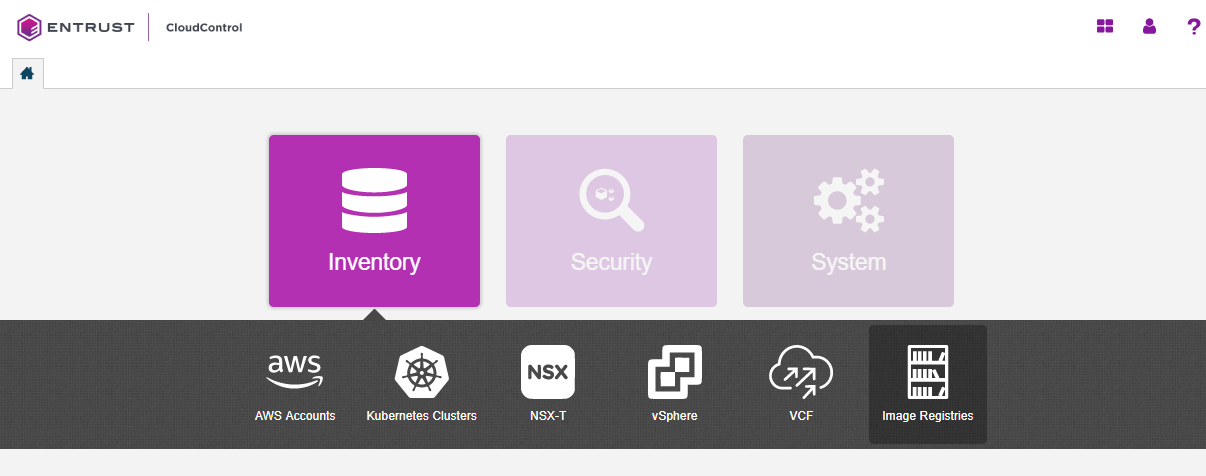
-
On the Image Registries page, select Actions > Add Registry.
If there are no registries in the system, select the Add Registry link on the Image Registries page.
-
On the Add Registry page, in the About tab enter the following information:
-
Name - Name of the registry
-
IP/FQDN - Enter the IP Address or FQDN for the registry.
-
Port - Enter the registry port used in configuration of the local registry.
-
Authorization Schema - Choose one of the following to use for authorization: BASIC or OAUTH.
-
User - Enter the username for the registry.
-
Password - Enter the password for this user.
-
Description - Enter an optional description.
-
-
Select Continue.
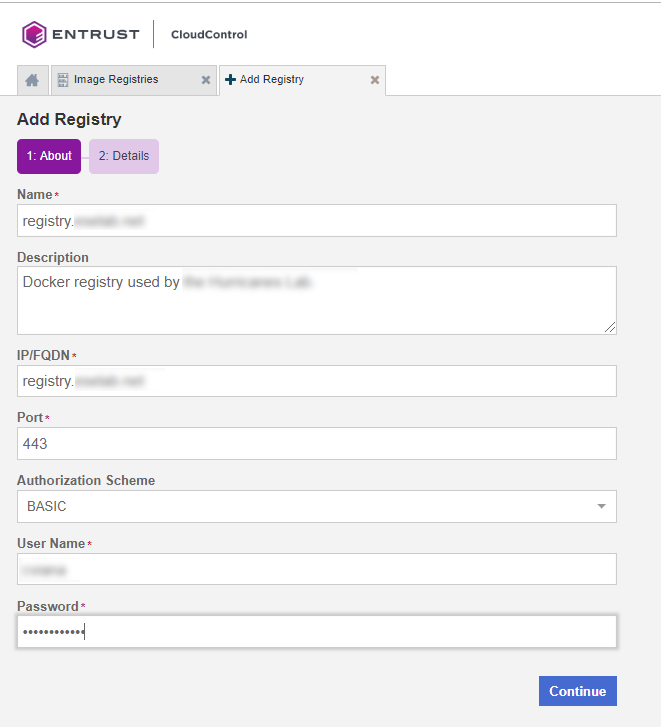
If certificate authority has not already been added, the system prompts the user to add one.
-
In the Missing Certificate Authority window, select Install Certificate Authority Now.
-
On the Install Certificates page, do one of the following:
-
Select Import and then select Browse to locate the certificate file.
-
Select Enter Text, then paste the contents of the certificate as plain text into Certificate Data.
-
-
Select Continue.
-
On the Details page, monitor the process.
-
Select Continue to view the dashboard for the newly added registry.
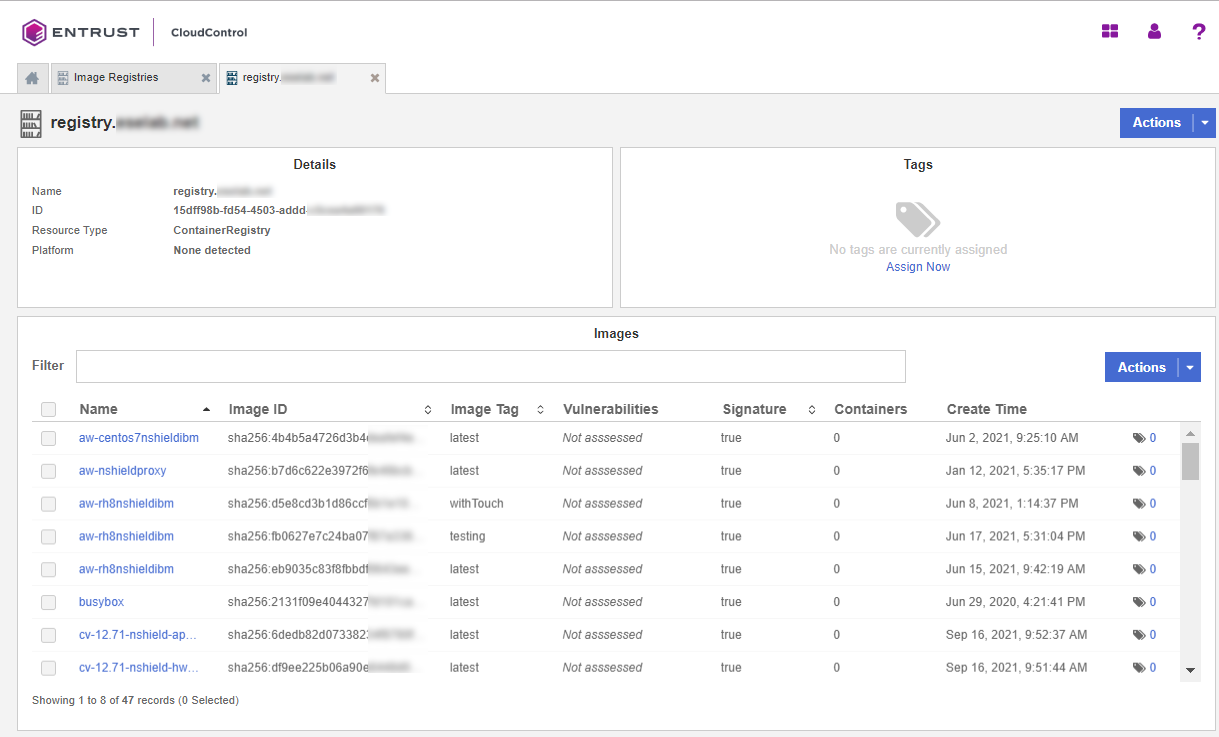
Now create an Image Deployment Control Policy, see Image Deployment Control Policy.
Image Deployment Control Policy
The Image Deployment Control Policy controls how images are deployed in the Tanzu Kubernetes cluster managed by CloudControl. As part of a Trust Manifest, it allows the user to determine what images from a registry are safe to be added to protected clusters.
CloudControl enforces image security using Image Deployment Control Policies, which are comprised of one or more deployment rules:
Private registry rules
-
Private Registries
Allows the user to enter a list of private registries, either onboarded or not, to be evaluated with the trust manifest. Only the images from registries listed in the Allowed Registries section are evaluated to see if they can be deployed. Images from all other registries will be denied.
-
Signature Rule
Allows the user to deny images that do not have an associated digital signature.
-
Attributes Rule
Allows the user to deny or deploy images based on their image ID or image name.
-
Vulnerabilities Rule
Allows the user to deny or deploy images based on CVSS scores or specific CVEs.
Public registry rules
A public registry rule enables images from public registries to be deployed in the environment without any evaluation.
| Entrust strongly recommends leaving the public registry rule set to ENABLED and not allowing public registries to be deployed. If a public registry must be used, then leave the rule set to ENABLED and enter that specific registry into the allowed registries. This will allow only that specific registry image to be deployed, and will prevent all other public registry images from deployment. |
Other considerations
Rules can either have a True or False value and can also include a 'stop processing' clause. Deployment rules in a policy are evaluated in the following order:
-
If False, the image will not be deployed, and no further rules are evaluated.
-
If True, AND there is a 'stop processing' clause, the image is allowed to be deployed and no further rules are evaluated.
-
If True, the next rule in the policy is evaluated. If this is the only rule, then the image is allowed to be deployed.
-
If all rules are True, then the image is allowed to be deployed.
| Entrust recommends always using the image SHA as it is a unique identifier for the images. Pods can be created by using either an image name with tag, or an image name with SHA, and in many cases images with the same SHA could have been tagged with different tags. For example, a single image named TestImage could have different tags, TestImage:3, TestImage:4, and TestImage:5, but all these images will have the same SHA because the underlying image is the same for all three of them. |
When any Image Deployment Control Policy rule is created, use the image name with SHA to ensure that the intended image is evaluated no matter what tags are there. When an image name with tag is used, such as TestImage:3, then only the image that matches that specific tag will be selected. The other images, TestImage:4 and TestImage:5 will not be evaluated.
Create an Image Deployment Control Policy
This section will show how an Image Deployment Control Policy is used to control which images are allowed/denied in the deployment.
For more information refer to Creating a Deployment Control Trust Manifest from the CloudControl GUI in the online documentation.
-
From the Home tab, select Security > Trust Manifests.
-
On the Manage Trust Manifests page, select Actions > Create Trust Manifest.
-
On the Details tab of the Create Trust Manifest page, enter the Name and optional Description for the trust manifest.
-
For Policy Type, select Deployment Control.
-
In the Deployment Control Rules: Private registries section:
-
For Allowed Registries, enter the registries to allow. That is:
-
Enter the registry that was onboarded: xxxxx.yyyy.zzz.
-
Registries can be existing onboarded registries or registries that will be onboarded later.
-
Registries that have not been onboarded are depicted with a yellow warning icon.
-
-
-
In the Deployment Control Rules: Rules section:
-
For Signature Rule, select either Enabled or Disabled. This determines whether to deny an image when no signature is present.
-
-
In the Deployment Control Rules: Rules section:
-
For Attribute Rule, select Enabled or Disabled to determine whether to evaluate using attributes, and then complete the following:
-
Name - Enter the name of the rule. The name cannot contain any special characters.
-
Exemption List - Deploy on Match
Select ENABLED or DISABLED to determine whether to use this when evaluating.
If ENABLED, use the + and - symbols to add the following criteria:
-
Image ID - Enter the image ID in SHA format to match.
-
Image Name - Enter the Name and Tag Regex to match.
If there is a match, the image will immediately be deployed, and no other deployment policy rules will be evaluated.
If there is no match, continue to the next enabled step.
If there are no other steps, continue to the next rule in the deployment policy.
-
-
Whitelist - Deny on No Match
Select ENABLED or DISABLED to determine whether to use this when evaluating.
If ENABLED, use the + and - symbols to add the following criteria:
-
Image ID - Enter the image ID in SHA format to match.
-
Image Name - Enter the Name and Tag Regex to match.
If there is no match, the image will immediately be denied, and no other deployment policy rules will be evaluated.
If there is a match, continue to the next enabled step.
If there are no other steps, continue to the next rule in the deployment policy.
-
-
Blacklist - Deny on Match
Select ENABLED or DISABLED to determine whether to use this when evaluating.
If ENABLED, use the + and - symbols to add the following criteria:
-
Image ID - Enter the image ID in SHA format to match.
-
Image Name - Enter the Name and Tag Regex to match.
If there is a match, the image will immediately be denied, and no other deployment policy rules will be evaluated.
If there is no match, continue to the next rule in the deployment policy.
-
-
-
Optional. In the Public Registries section, add public registries to be deployed without any evaluation.
Entrust recommends leaving this section enabled, but not entering any values for Allowed Registries.
-
-
Select one of the following:
-
Validate - Validate the draft or existing trust manifest.
-
Save - Save the trust manifest as a draft.
-
Publish - Publish the trust manifest.
-
Image Deployment Control Policy examples
In this example, an Image Deployment Control Policy is created. It will only allow images that are in the private registry that was onboarded earlier. Any other image that is not in the private registry will be blocked and will not run.
To be able to publish the policy:
-
The Restrict Public Registry rule will be enabled.
-
A fake registry name abc will be added to the exception list. This will force the policy to only allow images in the private registry.
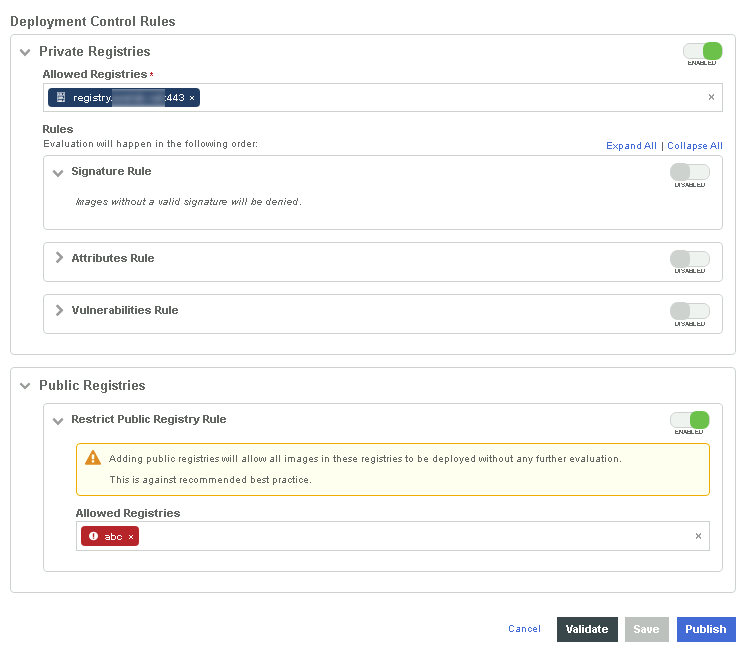
After this policy is published, it is possible to deploy an image that is not in the registry.
For example, using the pod.yaml file again:
apiVersion: v1
kind: Pod
metadata:
name: tutum-centos3
spec:
containers:
- name: tutum-ssh-server3
image: tutum/centos| The YAML file is not using an image from the private registry. |
% kubectl create -f pod.yaml
Error from server (Forbidden): error when creating "pod.yaml": admission webhook "deploymentcontrol.hytrust.com" denied the request: Permission Denied by HyTrust Security Policy.In this example, the pod was not deployed because it uses an image from the tutum registry.
To use an image from a private registry using a different YAML file.
For example, pod-internal-registry.yaml with the following content:
apiVersion: v1
kind: Pod
metadata:
name: internal-registry-centos
spec:
imagePullSecrets:
- name: regcred
containers:
- name: internal-registry-centos
image: xxxxxx.yyyy.zzz/cv-centos:latestAssuming the ImagePullSecret regcred which has the credentials to access the private registry has been created, create the pod:
% kubectl create -f pod-internal-registry.yaml
pod/internal-registry-centos createdThe deployment is successful, because the Image Deployment Control Policy allows images from the private registry.
Add the tutum external registry to the external registry exception list, so an external image can also be deployed. For example:
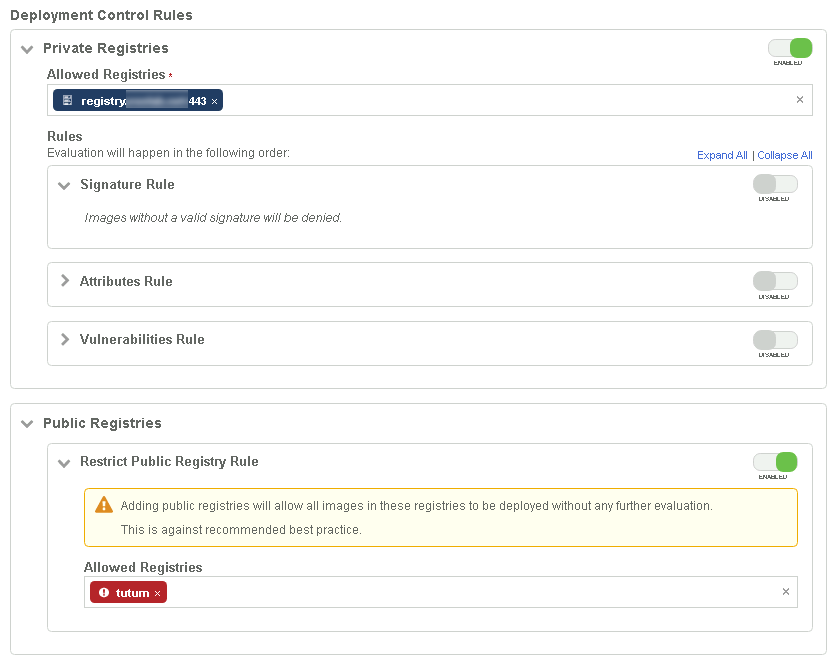
Create the pod using pod.yaml file again:
% kubectl create -f pod.yaml
pod/tutum-centos3 createdThe deployment policy is working as designed.
Expand the policy by further restricting what images can be deployed from the private registry.
To determine what images are in the private registry:
-
In the Home tab, Select Inventory > Image Registries and select the private registry that was onboarded.

-
Look at the images that are available in the registry.
Change the deployment policy to only allow images with name cv-centos and with the latest tag. Any other image in the private registry that does not match this requirement in the name will be blocked.
To do this, add an Attribute Rule to the deployment policy. For example:
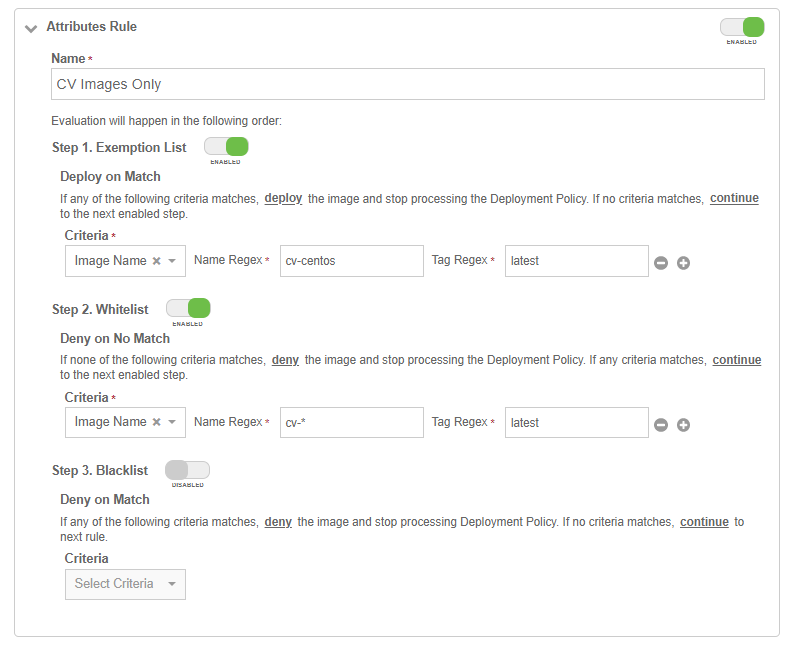
Now try to deploy the busybox image in the private registry.
To do this, create a file called pod-internal-busybox.yaml with the following content:
apiVersion: v1
kind: Pod
metadata:
name: internalregistry-busybox
spec:
imagePullSecrets:
- name: regcred
containers:
- name: internalregistry-busybox-test
image: xxxxxx.yyyy.zzz/busyboxWhen this is deployed, it should fail and deny the deployment. For example:
% kubectl create -f pod-internal-busybox.yaml
Error from server (Forbidden): error when creating "pod-internal-busybox.yaml": admission webhook "deploymentcontrol.hytrust.com" denied the request: Permission Denied by HyTrust Security Policy.Now deploy the cv-centos image in the private registry.
To do this, use the pod-internal-registry.yaml file again.
% kubectl create -f pod-internal-registry.yaml
pod/internal-registry-centos createdThe deployment is successful.
This demonstrates how to harden the Image Deployment Control Policy.
Image Deployment Control Policy based on vulnerabilities
When onboarding a private registry into CloudControl, the system checks the number of vulnerabilities in each image in the registry. Below is an example of a private registry when it was onboarded.

For each image, CloudControl collects the number of vulnerabilities and their types. Select a link in the Vulnerabilities column to view a pop-up with tabs that include the details.
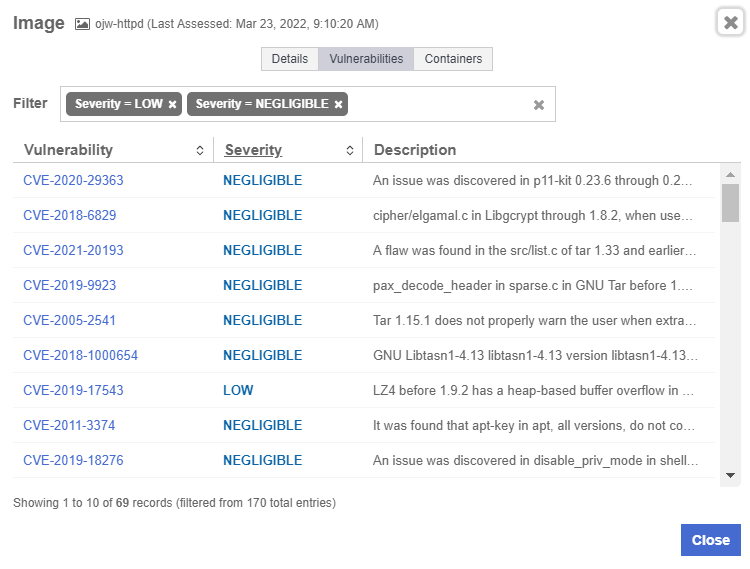
The Vulnerabilities tab lists each vulnerability with their CVE, severity, and description. Select the CVE link to view details about the CVE. For example:
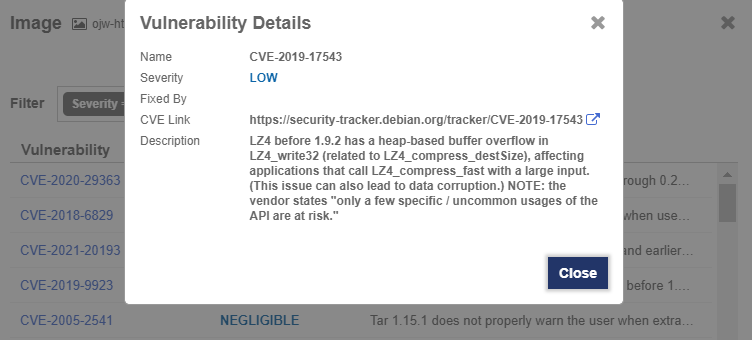
With this information on hand, create/modify the Image Deployment Control Policy to allow/deny deployments based on the number of vulnerabilities an image contain.
For example, modify the current Image Deployment Control Policy to allow any image from the private registry, but only if it has no vulnerabilities. This requires the use of two images from the private registry:
-
cv-centos - which has no vulnerability.
-
ojw-httpd - which has some vulnerabilities.
Modify the Image Deployment Control Policy
Modify the policy by disabling the Attributes Rule and enabling the Vulnerabilities Rule. The default thresholds will be appropriate for testing.
-
From the Home tab, select Security > Trust Manifests.
-
On the Manage Trust Manifests page, select the deployment control policy created earlier.
-
Select Edit.
-
Disable the Attribute Rule section under Rules, under Private Registries.
-
Enable the Vulnerability Rule section.
-
Give a name for the rule, for example My Vulnerability Rule.
-
Take the defaults for the Deny deployment thresholds values.
The ojw-httpd image has more than 30 low severity vulnerabilities.
-
-
Select Validate and the select Apply.
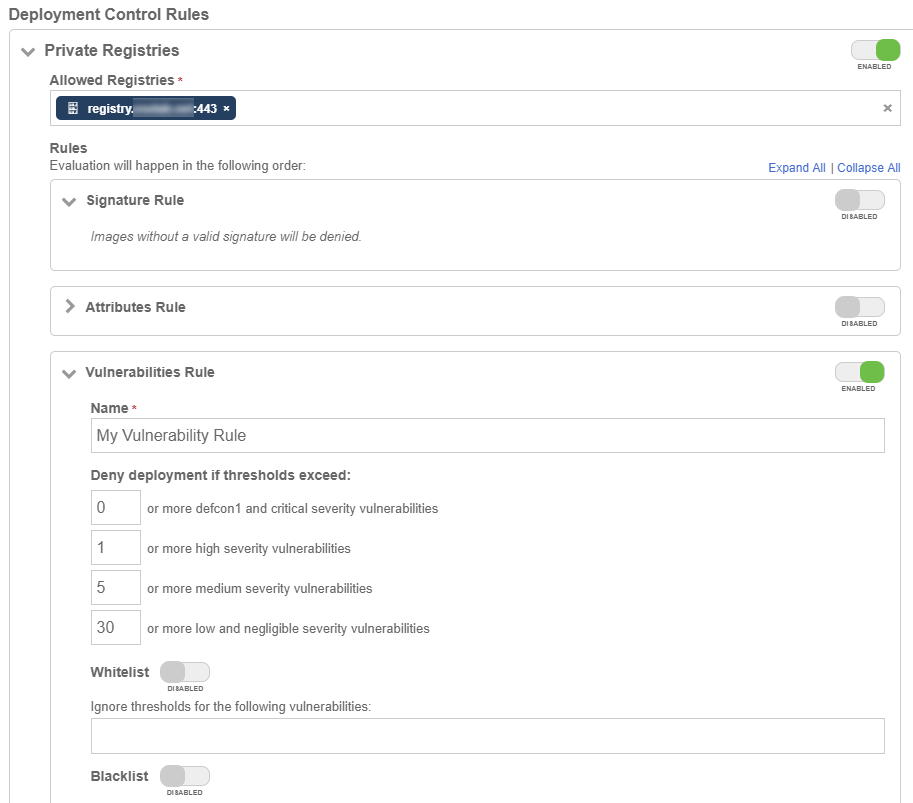
Test the policy, see Test the policy.
Test the policy
To test the policy, attempt to deploy the cv-centos image.
Use the same pod-internal-registry.yaml file again.
% kubectl create -f pod-internal-registry.yaml
pod/internal-registry-centos createdThe deployment succeeds.
Now attempt to deploy the ojw-httpd image.
To do this, create a file called pod-internal-cve.yaml with the following content:
apiVersion: v1
kind: Pod
metadata:
name: internalregistry-ojw-httpd
spec:
imagePullSecrets:
- name: regcred
containers:
- name: internalregistry-ojw-httpd
image: xxxxxx.yyyy.zzz/ojw-httpd:latestIt should fail and be denied.
% kubectl create -f pod-internal-cve.yaml
Error from server (Forbidden): error when creating "pod-internal-cve.yaml": admission webhook "deploymentcontrol.hytrust.com" denied the request: Permission Denied by HyTrust Security Policy.Examine the logs to see the denial.
-
Go to the Home tab, select Security > Log Analysis.
-
Select the record that shows the Deny status to see the reason for the denial.
-
Look for something like this:

This feature from CloudControl allows the user to put in place image deployment control policies that can harden the organization deployment requirements and tailor this capability according to the organization needs.
Configuration hardening
Configuration hardening allows the user to improve the security posture of Kubernetes environments by hardening the configuration to meet the company’s specific security policy and industry best practices. By automating the hardening process, the user can reduce the operational burden during a compliance audit.
With CloudControl, the user can:
-
Create and customize templates to use in configuration hardening checks.
-
Assess and remediate your environments against the configuration hardening checks defined in the templates.
-
Review dashboards, reports and alerts to monitor the results of assessments and remediations.
About templates
CloudControl uses templates to support all configuration hardening activities. CloudControl supports the following types of templates:
-
Catalog templates - Read-only collection of hardening operations. There is a Kubernetes operations catalog of templates that can be used.
-
System templates - Read-only collection of operations derived from a catalog template for a given compliance standard
-
Custom templates - Templates created by users. In most cases, they are copied or cloned from existing system or catalog templates. Custom templates can be modified and used in configuration hardening policies.
| CloudControl also includes sample custom templates that can immediately be used in a policy. |
Templates can contain both assessment and remediation hardening operations. Review all operations in the template to ensure that any parameter values are set appropriately for the infrastructure requirements.
About policies
Configuration hardening policies are used to run custom templates. Each policy associates a template with one or more resources or tag-based resource configurations and can be run manually or as a scheduled activity. Policies can either assess or remediate a resource but cannot do both.
More information
Consult the online documentation for more information on Configuration Hardening.
Creating a configuration hardening policy example
For this guide a configuration hardening policy will be created based on one of the templates available.
-
From the Home tab, select Security > Configuration Hardening.
-
On the Configuration Hardening Management page, select the Policies tab.
-
Select the Create (+) button.
-
In the Create Policy wizard on the Select Type page, select the type of policy that you want to create. This can be one of the following:
-
Assess Only - Runs operations on the host to compare the parameter values specified in the template with the actual values on the host.
-
Remediate Only - Modifies the parameter values on the host in order to match the values specified in the templates.
-
-
Select Assess Only.

-
Select Continue.
-
On the Details page, enter the name and optional description of the policy, and specify whether the policy is enabled.
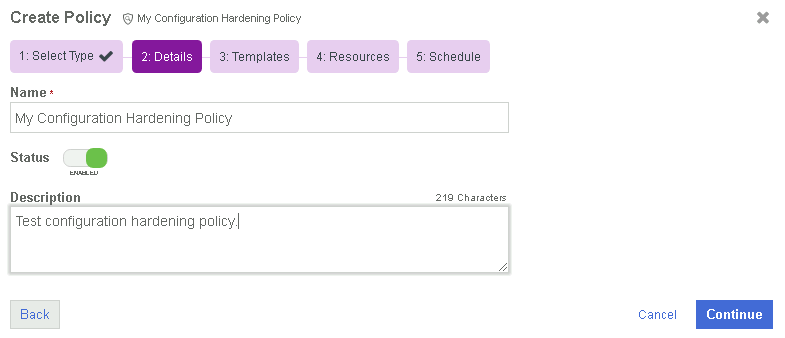
-
Select Continue.
-
On the Templates page, select the resource type for the policy. This can be one of the following:
-
AWS Account - Runs AWS-related templates against your AWS environment.
-
ESXi - Runs vSphere related templates against your ESXi hosts.
-
Kubernetes - Runs Kubernetes related templates against your Kubernetes environment.
-
NSXDataCenter - Runs NSX-T related templates against your NSX-T environment.
-
-
Select Kubernetes as the template to run against your environment.
-
The template list displays the name, description and type of operations Select a template that contains the type of operations that you selected for the policy.
-
Select Kubernetes - HyTrust Best Practice with HyTrust default values template. This template is used in the example.
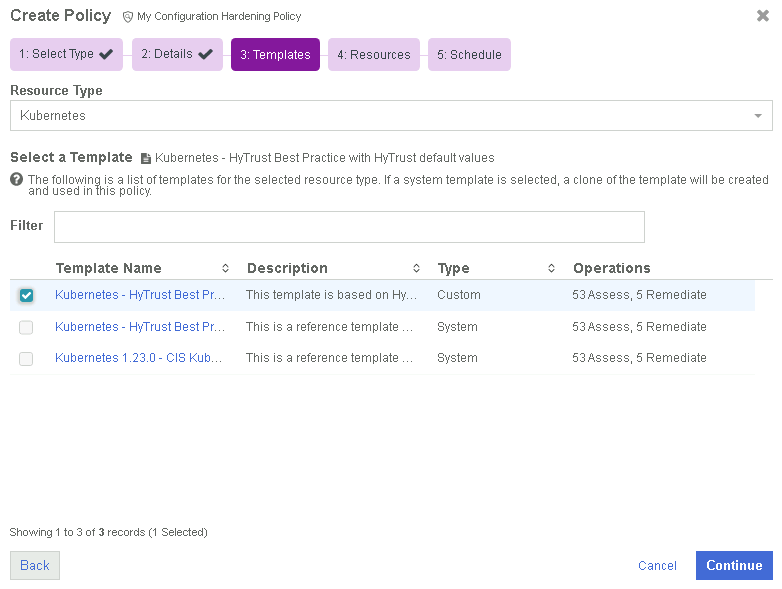
See the online documentation for more information on Creating a Custom Template. -
Select Continue.
-
On the Assignments page, select one of the following and choose the resources to apply the policy to:
-
Tags - Select the Tags radio button and then choose a tag or tags assigned to the resource. Select the + icon to assign more tags to the resource. If there are no tags assigned, select the Assign Tags Now link.
-
Resources - Select Specific Resources and then choose one or more resources.
-
-
Select Resources for the resources to apply the policy to.
-
Select the Kubernetes cluster that has been onboarded.
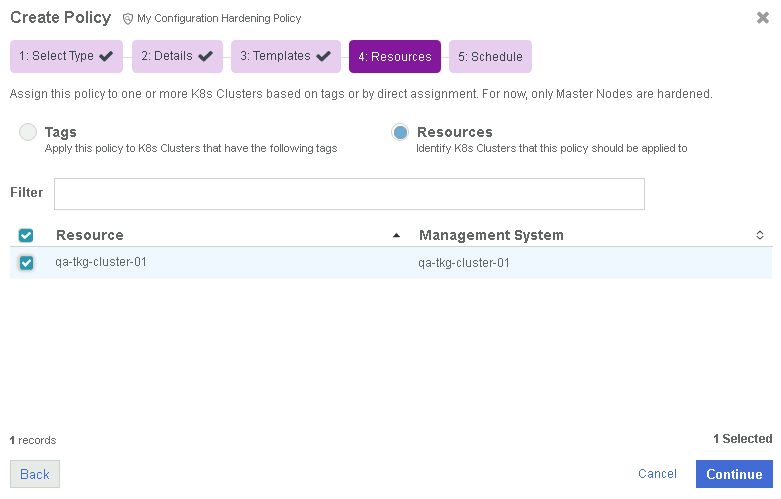
-
Select Continue.
-
On the Schedule page, enable a recurring schedule if required.
If enabled, select the type of schedule to use to run the policy and specify the start date. This can be one of the following:
-
Daily - The policy will run every day at the specified time.
-
Hourly - The policy will run periodically throughout the day, based on the defined schedule.
-
Weekly - The policy will run on every day that you select at the specified time.
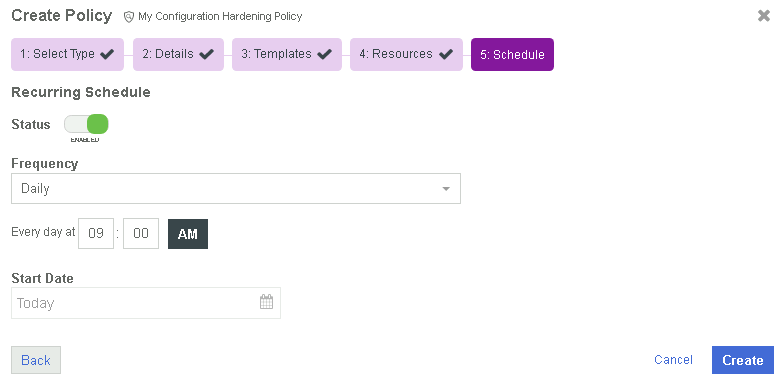
-
-
Select Create.
-
The new policy appears on the Policies tab.

Adding credentials to Tanzu master nodes
This is required to be able to run the configuration hardening policy. Follow the instructions, as described here, on how to SSH to Tanzu Kubernetes Cluster Nodes as the System User Using a Password.
After obtaining the password, save it. This password is used to store the credentials of the master nodes in CloudControl. For example:
Credentials : vmware-system-user / zeaIHcnKYYINzqF6TQ6D3c4gSuVUtJizl35uxKZ+Ks8=-
Navigate to the Tanzu cluster.
-
From the Home tab, select Inventory > Kubernetes Cluster.
-
Select the link for the Tanzu cluster. In this case the qa-tkg-cluster-01.
-
On the qa-tkg-cluster-01 page, select the Nodes tab. Add any missing credentials to the master nodes.

-
Select the master node and then from the Actions Menu select Update SSH Access Credentials.

-
In the Add SSH Credentials window, enter the User Name and Password saved earlier.

-
Select Save.
-
Do this for all the master nodes in the cluster.
Run the new configuration hardening policy
When running a remediation policy, the assessment policy automatically runs immediately following its completion. This ensures that the compliance score is updated with the new percentage.
-
From the Home tab, select Security > Configuration Hardening.
-
On the Configuration Hardening Management page, select the Policies tab.
-
Select the policy that you want to run.
-
Select Actions > Run Now.
-
You can view the results by selecting the link in the Last Event column after the configuration hardening policy finishes running.
-
Select View Full Results.

When viewing the full results, if you see a warning message indicating that it "Failed to Assess one or more resource(s)", make sure you have added the credentials to all Tanzu master nodes to perform compliance. See Adding credentials to Tanzu master nodes for more details. -
In the Last Event Summary Tab, select Resource.
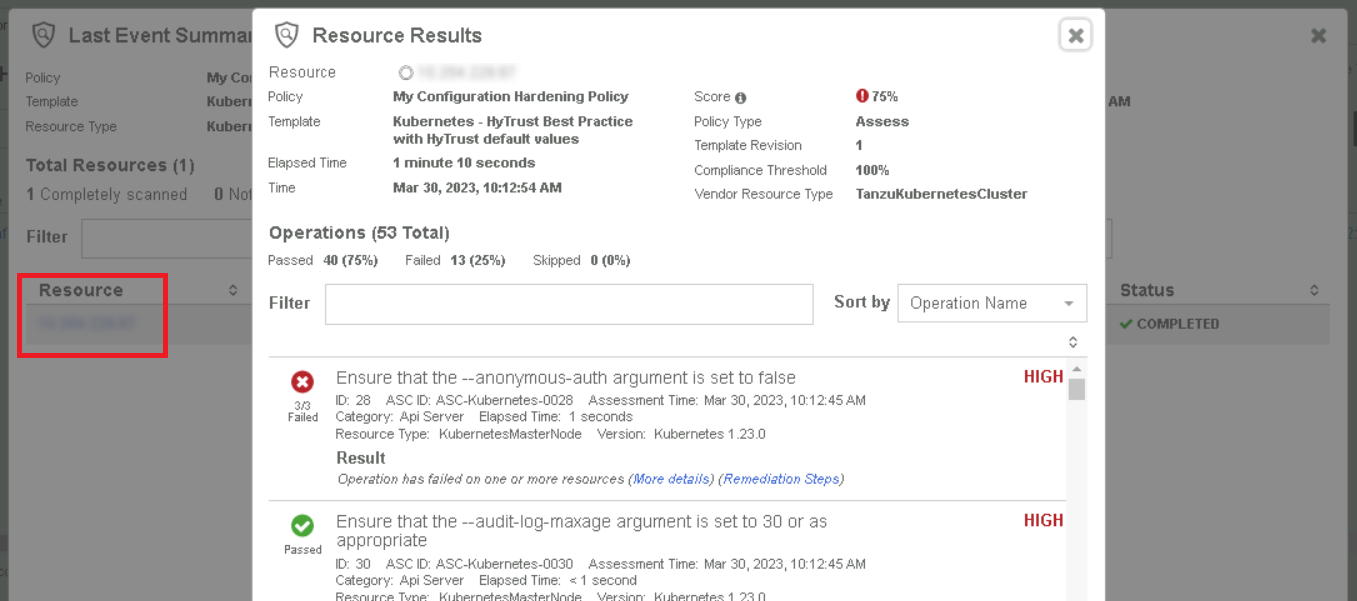
-
Check the results to see whether each test in the policy Passed or Failed. Select the More details link to get details on the result for each of the master nodes in the cluster. For Failed tests, select the Remediation Steps link to get information on how to remediate the problem.